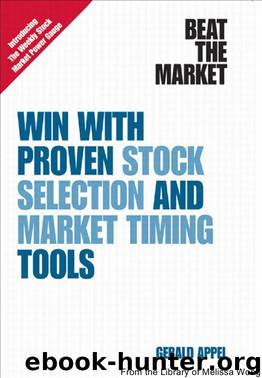Beat The Market by Appel

Author:Appel [Appel]
Language: eng
Format: epub
Published: 2010-08-10T19:05:11.359000+00:00
TWIBBS
58.2%
81.8%
18.2%
13.4%
–1.8%
+10.7% +11.6%
20.7%
–16.7%
Beat the Mark
et
From the Library of Melissa Wong
ptg
Creating the Best Blends of Risk and Reward in Your Portfolio 91
Notes
(A) Based on time spent in most bullish zones only.
(B) Both Baa and Treasury Bond-Stock Valuation Models
must be in most favorable zones.
(C) Either Baa or Treasury Bond-Stock Valuation Models
ptg
may be in most favorable zones.
(D) From the time the most favorable Weekly Breadth
Signal enters buy-hold position to the cancellation of hold signal. When applied within TWIBBS, certain conditions apply that
improve the performance of the Weekly Breadth Signal indicator.
“Annualized Rate of Return” is profit on a full-year basis for this particular signal. For example, the Baa Bond-Stock
Valuation Model, which is invested 36.6% of the time, produced average annual returns of +7.2%.
“Return While Invested” is the rate at which gains are
achieved. For example, the Baa Bond-Stock Valuation Model
produced profit of 548.73% while in the market 9.8 of the 26.8
years between 1981–2007. The rate of return was 21.0%, per
annum or twice the rate of return of buy-and-hold.
“Maximum Drawdown” is the worst interim loss taken by following this model, before profits reached new all-time highs. This is a measure of the minimum past risk of trading by this model. All the timing models have excellent risk/reward ratios over
a quarter of a century. Next, examine additional measurements
of past performance.
From the Library of Melissa Wong
92
Beat the Market
Risk-Return Relationships of Buy-and-Hold
Portfolios over the Years
Table 7.2 shows risk-return relationships for investment
portfolios including stocks and bonds, both maintained on a
buy-and-hold basis, from 1956–2005 (source: Ibbotson
ptg
Presentation Materials © 2006).
TABLE 7.2
Rates of Return and Risk Levels, Stock-Bond Portfolio
Allocations
Stock—Standard & Poor’s 500 Index; Bonds—U.S. Intermediate Government
Percent Percent Annual
Returns
Stocks
Bonds
Highest
Average
Lowest
100
0
+41.1%
+10.3%
–24.9%
90
10
+38.9
+10.2
–23.3
80
20
+34.4
+9.9
–20.0
70
30
+31.2
+9.6
–16.8
60
40
+29.2
+9.3
–13.6
50
50
+27.1
+8.9
–10.4
40
60
+26.0
+8.6
–7.2
30
70
+26.8
+8.1
–4.0
20
80
+27.6
+7.7
–3.9
10
90
+28.3
+7.2
–4.5
0
100
+29.1
+6.8
–5.1
The table is an historical evaluation of buy-and-hold investment portfolios with ratios of assets of stocks, represented by the Standard & Poor’s 500 Index and bonds, represented by the relatively low-risk, 10-year intermediate U.S. Government
treasury bond. The highest single year returns of portfolios of the ratios of bonds and stocks is shown, and the average performance of different blends and the largest historical risk levels are shown.
From the Library of Melissa Wong
Creating the Best Blends of Risk and Reward in Your Portfolio 93
In the analysis of timing indicators (refer to Table 7.1),
“Maximum Drawdowns” represent more stringent tests of risk
than “Lowest Annual Returns,” because losses during bear
markets often spread over more than just one year. They
exceed losses taken in any single year. Also, because the worst ptg
drawdowns are the moments of greatest loss, they are unlikely
to take place right at year’s end. To this extent, Table 7.2 underestimates actual historical risk levels.
Analysis of Table 7.2: The Best Pockets of
Investment Blends
It might be difficult to tolerate the risk of a portfolio 100%
committed to stocks. Between 1956–2005, portfolios fully
invested in the Standard & Poor’s 500 Index had their best year at +41.1%, an average annual gain of +10.3%, but a greatest
single-year loss of 24.9%.
Why Not Losing Is More Important Than
Winning
Portfolios fully committed to stocks would be the best performing of the portfolio mixes. However, actual losses of 24.9%
can be ruinous to a retired investor, living off his assets. For example,
Download
This site does not store any files on its server. We only index and link to content provided by other sites. Please contact the content providers to delete copyright contents if any and email us, we'll remove relevant links or contents immediately.
Rich Dad Poor Dad by Robert T. Kiyosaki(6174)
Pioneering Portfolio Management by David F. Swensen(6078)
How To Win Friends and Influence People by Dale Carnegie(4332)
The Money Culture by Michael Lewis(3846)
The Dhandho Investor by Mohnish Pabrai(3560)
The Wisdom of Finance by Mihir Desai(3523)
Liar's Poker by Michael Lewis(3220)
The Intelligent Investor by Benjamin Graham Jason Zweig(2930)
The ONE Thing by Gary Keller(2918)
Mastering Bitcoin: Programming the Open Blockchain by Andreas M. Antonopoulos(2890)
Fooled by Randomness: The Hidden Role of Chance in Life and in the Markets by Nassim Nicholas Taleb(2860)
Rich Dad Poor Dad: What The Rich Teach Their Kids About Money - That The Poor And Middle Class Do Not! by Robert T. Kiyosaki(2833)
How to Win Friends and Influence People by Dale Carnegie(2793)
Investing For Dummies by Eric Tyson(2791)
How to Day Trade for a Living: Tools, Tactics, Money Management, Discipline and Trading Psychology by Andrew Aziz(2784)
Market Wizards by Jack D. Schwager(2538)
Zero Hour by Harry S. Dent Jr. & Andrew Pancholi(2531)
How to Pay Zero Taxes, 2018 by Jeff A. Schnepper(2497)
Rich Dad's Guide to Investing by Robert T. Kiyosaki(2410)
